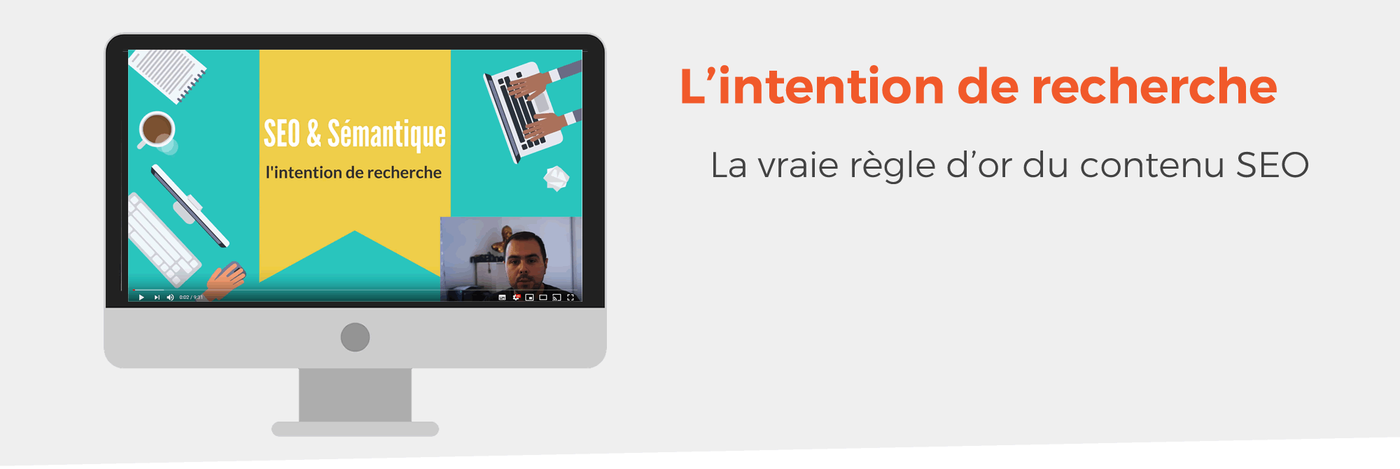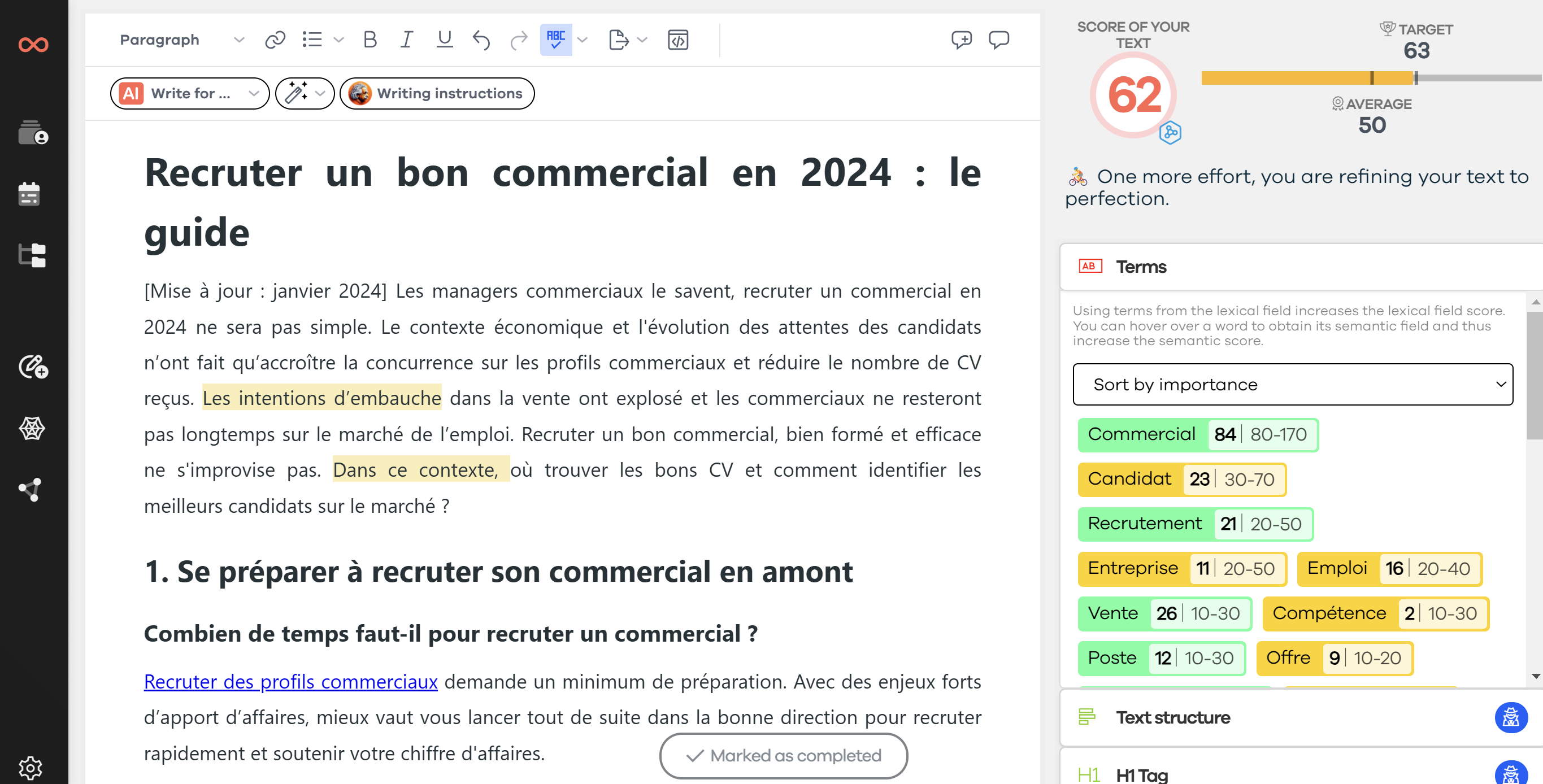Recently, a client brought up an issue to me, they have articles that are stuck at the very bottom of Google's first page. And they don't know why!
Even worse, they've spent a crazy budget on technical optimization, site loading speed, link acquisition, but nothing is happening!
In this post, we're going to see how to write high-performing SEO content thanks to a golden rule.
This is the type of content that ranks in Google's TOP 3 and attracts hundreds of visitors.
One of the golden rules before any content writing for organic search is to respect the Search Intent of the user for the targeted keyword.
We're going to see what Search Intent is and especially how to determine it effectively.
What exactly is Search Intent?
Search Intent is the reason why users perform a specific search on Google. Before any optimization or writing actions for a targeted keyword, you should ask yourself:
- Why are users performing this search?
- Are they looking for a specific website?
- Are they looking for an answer to a question or are they simply looking to buy something?
A search engine, like Google, aims to meet the needs and expectations of the user. Its business model is based on this principle.
Over the years, Google has become increasingly capable of determining the search intentions of users. Google wants to rank the pages most suited to the intent in the top results. That's why it's essential to ensure that your content matches the search intentions of your target.
How to recognize a hidden search intent behind a keyword?
Some of you regularly ask me "How to recognize the hidden intent behind a keyword". It's an excellent question, because answering the search intent of the user means understanding the expectations and needs of your target and ensuring a good ranking in Google.
So here's an example for the key phrase "Choosing a lawyer". One might rightly wonder whether it's a search intent on the fruit avocado or the profession of a lawyer.
Type the keyword into Google and you'll see that 80% of the results page corresponds to the fruit and 20% to the profession of a lawyer.
By the way, a small parenthesis: Google knows lexical fields quite well (especially thanks to the integration of Google Rankbrain into its algorithm).
Try it out and test the lexical fields: complete the search "choose a lawyer" with the term "ripe" or "criminal". Google's search results will take a completely different form since Google knows to attribute the term "ripe" to the fruit and the term "criminal" to the profession of a lawyer.
How to determine the right search intent for a keyword?
As we just saw, a search result can consist of a multitude of search intents. To be able to create high-performing SEO content, you need to understand Google's results page.
Keep in mind that the SERP (search engine results page) reflects the hidden intent behind the keyword.
[IMAGE]
So, here's a representation of the SERP for the query "insurance".
Let's break down the SERP:
- An Adwords ad at the top of the page, like the one from Lynx.fr Insurance Comparator | Best Rates 2018. It seems to be an insurance site with an online simulator, but let's ignore the Adwords ads.
- In the first position of the organic results - Direct Insurance: Car, motorcycle,
This is a different type of result from the ad, it's more "We offer to insure your vehicles," and not, "We offer to compare insurance".
- In second position, Assurland.com: Car Insurance: Free Car Quote. Still an intent on car insurance.
- In 3rd position Wikipedia, the main article on insurance. We've clearly just changed intent. We're on a more informational intent.
- In 4th position, the site lesfurets.com Car Insurance: Comparator & Free Quote - we're clearly on an insurance comparison site
- And to finish off, lelynx insurance comparator online
At the bottom of the results page, there are associated searches.
Online car insurance / car insurance quote / cheap car insurance / car insurance / insurance comparator / home insurance
So, here's what's happening.
When you see search results like this, you need to pay very close attention to the intent/position ratio. Let's say:
- Intent n°1: I want car insurance
- Intent n°2: I'm looking for information on insurance
- Intent n°3: I want to compare insurances (in a broad sense: vehicle, health, home)
In the search engine results page, if you observe more of intent n°1 in the top positions, this indicates that more users prefer or are searching for this type of intent.
You can apply this principle to any search you perform.
I'm not talking about advertising results, because they don't need to meet a particular intent to exist.
So, if you're doing content optimization or if you're writing content to try to target a keyword, but the content created meets a lower intent on the results page, for example intent n°2 or 3, you risk getting stuck at the bottom of the first page.
Google will always highlight the search intent that meets the largest number of users for the targeted query (Note: Google can serve several intents per SERP).
What's also interesting is when you notice that there's only one intent in the associated searches. It will probably be very difficult to change the user's intent or to provide a different intent.
Second example to determine the search intent "pallet furniture"
We do the same exercise for the keyword "pallet furniture".
To describe this SERP, there are no Google Adwords ads. This is an interesting indication.
Next, Google displays an image block. If you see an image block ranking at the top of the organic results, you absolutely need to do SEO for Google images.
This is a clear indication that many users want images.
This means that Google Images probably receives a significant part of the search volume. When I see this, I generally assume that 20-25% of users will go to Google images rather than to the organic search results.
In addition, SEO in Google images is often much easier than ranking in the organic part.
In 2nd position in the ranking, a blog (overblog): Pallets as furniture - idea notebook (over-blog.com/pallets-as-furniture.html). In 3rd place, the site homelisty, Pallet Furniture: Ultimate Ideas (updated 2018).
A clear trend emerges, intent n°1: I'm looking for inspiration ideas for pallet furniture.
Then, we have a Youtube block with 3 videos: one on intent n°1, namely the 23 best ideas for pallet furniture and two other videos on making pallet furniture. This is a second search intent: furniture making.
Then, intent n°2 is confirmed in the rest of the SERP:
18h39.fr Tutorials to make outdoor pallet furniture and designmag.fr Making furniture with pallets by
My opinion on the keyword "pallet furniture": prioritize images and video. Intent n°1: I'm looking for pallet ideas seems to be underexploited on Youtube. This is a significant content opportunity for organic search.
1. Google's SERPs, the associated search can help you identify the user's intent that is hidden behind the keyword.
2. Don't be afraid to innovate by offering different types of content to your target (images, video, etc). In the long run, this will be beneficial for your marketing strategy.
3. Don't write content without first understanding your target. We can be misled about the intent by only looking at the keyword. However, by examining the SERP, you can get into the user's head.
To go even further, you can put into practice the principle of search intent in a concrete way via this post.
Know how to exploit, the gaps in unserved search intents, they can generate positioning opportunities, as we saw in the examples.
Need to go further?
If you need to delve deeper into the topic, the editorial team recommends the following 5 contents:
- YouTube SEO: How to Optimize Your Video for SEO
- Understanding and Creating the Perfect SEO Keyword List with Tools
- Content and SEO Optimization: The Complete Guide for SEO Specialists
- 8 SEO Mistakes to Avoid for Making Your Content Effective
- Long Tail and Qualified Traffic: The Keyword Strategy You Can't Miss

